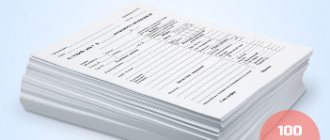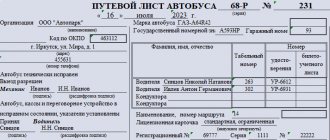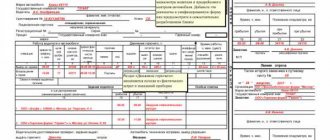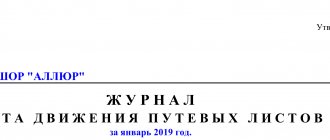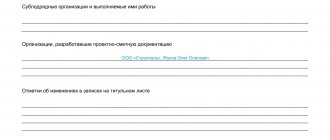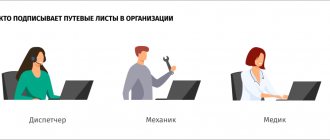Filling procedure
Form ESM 2 requires double-sided filling. The form is convenient, including for signing. The customer and the contractor must sign, but on different sides of the sheet. The performer means a person (or persons) who provides services for managing a working machine and performing current operations. The second part of the sheet has a separate column for the accountant. Taking into account the specified information, he calculates the salary of a specific employee.
First part
On the ESM 2 waybill form, in the first part you will need to write down:
- current OKUD form;
- a link to the resolution, taking into account which the decision was made to draw up the relevant papers;
- the name of the logistics organization providing transportation services or the name of another organization executing the current order (it is necessary to indicate the contact number and exact address);
- the name of the organization that ordered the service, the full name of the person in charge who hired the construction machine for current needs (contact information is also required);
- model name, car make with all official numbers (inventory, state, etc.);
- operational action type code;
- data of the driver, operator;
- operating time of equipment.
After this block of data there is a table.
Tabular part
The name, current address of the facility, the month and date of service provision, the dispatcher’s signature, and information taken from the speedometer at the time of departure must be indicated here. The driver confirms that the car was in good working order upon departure; the mechanic’s signature is indicated separately - this means that he confirmed the fact of service as stated by the driver.
The time it takes for the equipment to return to its permanent location is entered into the table; the data is checked against the speedometer. Again the driver and mechanic put their signatures. It is important to correctly indicate fuel consumption data. Absence after expense leads to shortages; it will be difficult to find out who is to blame for what. If ESM 2 sheets are filled out in a timely, correct manner, questions usually do not arise.
At the end of the plate of the ESM 2 waybill form, you need to indicate what the actual consumption was, write down the standard, and make a comparison. Then the signature of the tanker (driver) is affixed. Availability of information on service ID numbers is desirable, but not required.
Second side of the sheet
On the reverse side of the form there is a division into 2 parts. The left one is filled out by the customer of the service, and the right one is filled out by the owner of the car. In addition to the start and end time, number of works, address, object code, columns are provided with:
- general working out by the hour according to a specific waybill (issued based on the results of all current operations performed by the work acceptance party);
- price of options;
- the number of downtimes, the duration of each, through whose fault they occurred.
The information is confirmed by the seals and signatures of the responsible persons who accept the work.
The third part
She is there too. To enter information on the movement of a vehicle, the performance of certain tasks at night, on weekends and other odd hours (payment at a separate rate is provided), the right side is provided on the back. The payment type code is indicated there.
The total mileage of the car according to the route form and the time spent by the driver while standing on the line are indicated. At the end of the paper there is space for possible claims from the customer (you can leave the field blank), signatures of the driver, foreman, department manager, and accountant.
We need a conclusion to the plate. Enter the calculated cost of each machine hour. This information will be the basis for possible optimization of the organization's current processes in the future (if there is a need). ESM 2 for construction machines is drawn up according to the same rules, all of them are equally important.
Form ESM-2: what you should pay attention to when filling out a voucher
The ESM-2 waybill can be issued to the driver (driver) of a vehicle for one working day or shift, a working week, or a calendar decade.
In a standardized form, a sample waybill for the ESM-2 construction vehicle contains the following data:
on the front side:
- installation – serial number of the waybill (put down manually and corresponds to the serial number of the record of issue in the “Journal of Waybills Registration”), date of issue of the document, name of the company executing the order,
- type, make and registration details of the vehicle,
- information about the person driving the vehicle - surname and initials,
- technical data - speedometer readings, a mark on the amount of fuel, information about the serviceability of the vehicle (information about fuel and lubricants is written out as completely as possible - the remaining amount in the tank at the start of work (at departure), the amount of fuel filled into the tank, its balance at the time of return of the vehicle is indicated),
- data on the work order - information about the cargo (name, quantity, class, etc.) and the point of receipt, or the facility where the work will be carried out, the mileage between the departure point and the facility, the number of trips made;
on the reverse side:
- information for calculations – start and end times of work, number of hours spent on work / cargo transportation,
- downtime information,
- the amount of payment for the work, the actual mileage of the special equipment within the order.
The reverse side of the waybill is filled out both by the contractor - on the left side of the form (the owner of the vehicle), and by the customer of the work - on the right side.
Information about downtime of special mechanisms due to the fault of the customer must be confirmed by him with a personal signature and stamp.
The mandatory information that a correctly completed waybill for the ESM-2 construction vehicle must contain also includes information about checking the vehicle by a mechanic before leaving for the line. The mechanic makes a note in the appropriate boxes about the pre-trip inspection, certifying the entry with a handwritten signature.
As a result, a correctly executed waybill must be certified by the following signatures:
- dispatcher;
- driver (driver);
- release mechanics;
- customer (foreman);
- accountant or standard setter;
- head of the enterprise.
Download a sample and a waybill form for the ESM-2 construction vehicle
Waybill for construction vehicle ESM-2
Sample of filling out waybill for construction vehicle ESM-2
Attention! The Ministry of Transport, by order No. 368 of September 11, 2020, added new requirements for filling out waybills. The document came into force on 01/01/2021 and is valid until 01/01/2027.
What form is used as a waybill for construction equipment?
The waybill form used for self-propelled construction vehicles is one of those approved at the legislative level by Resolution No. 78. Its official name is “Construction vehicle waybill (form No. ESM-2).”
However, since 2013, the forms approved by Goskomstat are optional for use (information of the Ministry of Finance of Russia No. PZ-10/2012). That is, an organization can develop such a form independently, including the necessary details and fields. As a rule, when independently developing a form, the form approved by the State Statistics Committee is taken as a basis, and then those adjustments are made to it that the person who intends to use the form created in this way considers necessary.
Description of the parties
The document must be completed on both sides. This design is convenient when signing. On the one hand, the contractor (persons who provide services related to the work of the construction machine itself) signs, and on the other, the customers. Also on the second side there is a special column for an accountant who calculates the salary of a specific employee.
First side
The first one contains:
- OKUD form (0340002);
- reference to Resolution No. 78 of the State Statistics Committee of November 28, 1997, according to which the paper forms were adopted (this particular one received the number ESM-2);
- the name of the logistics company that provides transportation services, or the name of another company that fulfills the order (with address and telephone number);
- Full name or company name of the customer who hires a construction machine for any of his needs (also with written contact details);
- make and name of the car, its state number, as well as inventory and service records (below);
- Full name of the driver;
- transaction type code;
- period of work (indication of duration of activity);
- information about the column or work area (if available).
After this informative part comes the tabular part.
If we are talking about one day, then only one line is filled in. If several days (shifts) are required to complete the work, then each new line should contain information about a separate day. The tabular section states:
- the date and month in which the service was provided;
- name and address of the object;
- dispatcher signature (separate for each line);
- when the car left, speedometer readings when leaving (in km);
- the driver’s signature stating that the car was in good working order upon departure; the mechanic’s signature will also be required to express his agreement with this fact;
- the time when the equipment arrived at its permanent location, which was visible on the speedometer;
- signatures of the driver - in the delivery of the car and mechanic - that he accepted it upon arrival at the garage (in one column).
A special place in the document is given to fuel consumption. And this is not an accident. Lack of control over the consumption of fuels and lubricants usually leads to their shortage. Thus, the penultimate column of the table is dedicated to fuel and is divided into several sub-items, filled out separately:
- how much fuel was in the tank (or cylinder, if it is gas) when leaving;
- how much was issued to complete the work;
- how much is left upon arrival at the garage.
Also (at the very end of this column of the table) it is necessary to indicate what the actual consumption was and what it should be according to the standards.
Completes the tabular part of the column “Signature of the driver (refueler)”. At its level there are also the names of those who have taken responsibility for performing this type of work. Moreover, there is a place for both parties (on the part of the customer and the contractor). The riggers are not forgotten either. When filling out, it is advisable to write down their full name and service ID numbers.
Second side
On the back of the construction vehicle's waybill there is a clear division into two parts. On the left - filling by the customer, on the right - by the owner of the car. In addition to the number, start and end time, code and address of the object, type and stages of work, there are columns:
- how many total hours have been worked on this waybill (issued by the receiving party based on the results of completion);
- the cost of the work performed;
- how many downtimes there were, for what duration and due to whose fault.
The data is confirmed by the signatures and seals of the party receiving the service. Do not forget that the full name of the responsible person of the customer is also mentioned on the first sheet (but a signature is not required).
It is also worth considering the fact that driving and performing tasks at night, as well as on weekends, the driver must be paid at a special rate. Therefore, they are written down separately in the ESM-2 document: on the right side on the reverse side (indicating the payment type code).
IMPORTANT! The vehicle's mileage along this track and the time the driver spent standing on the line are also indicated here.
At the very end, in the final part of the paper, space is left for possible claims of the customer against the driver (to his work) and for the signatures of the foreman, driver, head of the department and the person who made the calculations (accountant).
As a conclusion to the table, it is advisable to indicate the calculated cost of one machine hour. This information can serve as a good basis for further optimization of the organization's activities.
Despite the fact that Letter of the Ministry of Finance dated August 25, 2009 No. 03-03-06/2/161 dated August 25, 2009 made it possible to independently develop waybills, this form remains in demand because of its convenience, information content and conservatism in business circles.
ATTENTION! If an organization dares to develop its own form of waybill for a construction vehicle, it will be subject to strict requirements. They are clearly stated in Order of the Ministry of Transport of Russia dated September 18, 2008 No. 152.
The procedure for using the ESM-2 form
Which subject is it used by?
It is used in organizations specializing in the provision of services for the provision of motorized construction machines.
An additional condition for the use of this document is the use of hourly wages for service personnel.
How many copies are compiled?
Compiled in one copy.
Which employee compiles
From the organization performing the work:
- An authorized person (or dispatcher) issues a waybill for a shift, for a day or a decade.
At the stage of work execution
From the organization performing the work:
- The driver of a construction vehicle fills out a waybill every day.
The mechanic and the gas station operator (if he is involved in the work process) also put their signature.
Sample of filling out a waybill
Let us consider in detail how to fill out each field using the example of form No. 3 (for a passenger car) for an individual entrepreneur. The sample, taking into account the latest changes, was prepared using the commercial version of ConsultantPlus.
Let's start by indicating the series, number and validity period of the document. The series is an optional element, so it may not be present. As for numbers, they are assigned to waybills in accordance with the approved numbering.
The validity period is determined depending on the situation. In our example, the document was issued for one shift.
The next section is for information about the owner or lessee of the vehicle.
Legal entities must write:
- Name;
- organizational and legal form;
- location address;
- contact number;
- OGRN.
- FULL NAME. (patronymic if available);
- mailing address;
- contact number;
- OGRIP.
Information about the vehicle itself must be indicated as stated in the documentation. When filling out you must write:
- make of car (can be in Latin or Cyrillic, the main thing is to make it clear);
- number received during state registration;
- parking number, if available. If it is not there, the field can be skipped, there will be no violation.
Responsibility for errors
Responsibility for the correct execution of documents rests personally with the head of the organization, as well as with authorized persons who are responsible for the operation of the vehicle. Those of them who sign the form are responsible for the accuracy of the data they certified. If, during an inspection, representatives of the Federal Tax Service reveal violations in filling out the waybill, they can exclude fuel and lubricants written off on it from expenses for profit tax purposes. Then the organization will have to pay additional tax, as well as pay fines and penalties assigned by inspectors.
